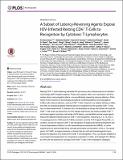A Subset of Latency-Reversing Agents Expose HIV-Infected Resting CD4⁺ T-Cells to Recognition by Cytotoxic T-Lymphocytes
Author(s)
O’Connor, Rachel; Rimpel, Katherine; Sloan, Derek D.; Karel, Dan; Wong, Hing C.; Jeng, Emily K.; Thomas, Allison S.; Whitney, James B.; Lim, So-Yon; Kovacs, Colin; Benko, Erika; Karandish, Sara; Huang, Szu-Han; Buzon, Maria J.; Lichterfeld, Mathias; Irrinki, Alivelu; Murry, Jeffrey P.; Tsai, Angela; Yu, Helen; Geleziunas, Romas; Trocha, Alicja; Ostrowski, Mario A.; Walker, Bruce D.; Jones, Richard Bradley; Mueller, Stefanie; Irvine, Darrell J; ... Show more Show less
DownloadJones-2016-A Subset of Latency-.pdf (2.094Mb)
OPEN_ACCESS_POLICY
Open Access Policy
Creative Commons Attribution-Noncommercial-Share Alike
Terms of use
Metadata
Show full item recordAbstract
Resting CD4⁺ T-cells harboring inducible HIV proviruses are a critical reservoir in antiretroviral therapy (ART)-treated subjects. These cells express little to no viral protein, and thus neither die by viral cytopathic effects, nor are efficiently cleared by immune effectors. Elimination of this reservoir is theoretically possible by combining latency-reversing agents (LRAs) with immune effectors, such as CD8⁺ T-cells. However, the relative efficacy of different LRAs in sensitizing latently-infected cells for recognition by HIV-specific CD8⁺ T-cells has not been determined. To address this, we developed an assay that utilizes HIV-specific CD8⁺ T-cell clones as biosensors for HIV antigen expression. By testing multiple CD8⁺ T-cell clones against a primary cell model of HIV latency, we identified several single agents that primed latently-infected cells for CD8⁺ T-cell recognition, including IL-2, IL-15, two IL-15 superagonists (IL-15SA and ALT-803), prostratin, and the TLR-2 ligand Pam₃CSK₄. In contrast, we did not observe CD8⁺ T-cell recognition of target cells following treatment with histone deacetylase inhibitors or with hexamethylene bisacetamide (HMBA). In further experiments we demonstrate that a clinically achievable concentration of the IL-15 superagonist ‘ALT-803’, an agent presently in clinical trials for solid and hematological tumors, primes the natural ex vivo reservoir for CD8⁺ T-cell recognition. Thus, our results establish a novel experimental approach for comparative evaluation of LRAs, and highlight ALT-803 as an LRA with the potential to synergize with CD8⁺ T-cells in HIV eradication strategies.
Date issued
2016-04Department
Massachusetts Institute of Technology. Department of Biological Engineering; Koch Institute for Integrative Cancer Research at MITJournal
PLOS Pathogens
Publisher
Public Library of Science
Citation
Jones, R. Brad, Stefanie Mueller, Rachel O’Connor, Katherine Rimpel, Derek D. Sloan, Dan Karel, Hing C. Wong, et al. “A Subset of Latency-Reversing Agents Expose HIV-Infected Resting CD4⁺ T-Cells to Recognition by Cytotoxic T-Lymphocytes.” Edited by David T. Evans. PLOS Pathogens 12, no. 4 (April 15, 2016): e1005545. doi:10.1371/journal.ppat.1005545.
Version: Final published version
ISSN
1553-7374
1553-7366